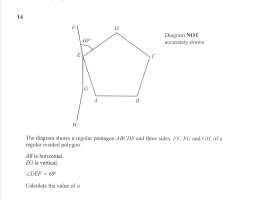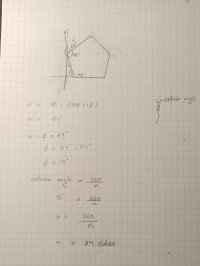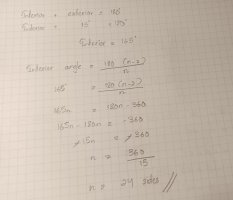You are using an out of date browser. It may not display this or other websites correctly.
You should upgrade or use an alternative browser.
You should upgrade or use an alternative browser.
Please solve: regular pentagon ABCDE; FE, EG, GH sides of regular n-gon; AB horizontal, EG vertical; m(<DEF)=69degrees
- Thread starter Laia
- Start date
The Highlander
Senior Member
- Joined
- Feb 18, 2022
- Messages
- 1,195
By extending the lines EG & AB as shown below...I subtract 69 from 72 which is an exterior angle of a regular polygon. That answer 3° (72-69) is in the require polygon so I can't count that as an exterior angle. I can't figure out how to calculate the value of n.
(I have helpfully added the interior angle of the pentagon
You should now be able to (easily, I trust
Once you have the exterior angle of the n-polygon you should be able to calculate its interior angle and, thence, the value of n.
If you are at all unsure how to proceed from there then read these pages first:-
Hope that helps.
Thank you! I'll try to find the answer by using the mentioned method.By extending the lines EG & AB as shown below...
(I have helpfully added the interior angle of the pentagon)
You should now be able to (easily, I trust) calculate in turn the sizes of the angles 1, 2, 3, 4 and 5 (which is the exterior angle of the n-polygon).
Once you have the exterior angle of the n-polygon you should be able to calculate its interior angle and, thence, the value of n.
If you are at all unsure how to proceed from there then read these pages first:-
Hope that helps.
The exterior angle (angle 5 in the photo) is 15° and the value of n is 24. Is that correct? Since the Pentagon is a regular polygon, all of it's interior angles are 108. So the angle 2 in the picture is 72° and the angle happened by connecting the line from AB and EG is 90. So The value of angle 3 is 18. And then I used the angle on straight line is 180° theorem to find the angle 4 and 5.By extending the lines EG & AB as shown below...
(I have helpfully added the interior angle of the pentagon)
You should now be able to (easily, I trust) calculate in turn the sizes of the angles 1, 2, 3, 4 and 5 (which is the exterior angle of the n-polygon).
Once you have the exterior angle of the n-polygon you should be able to calculate its interior angle and, thence, the value of n.
If you are at all unsure how to proceed from there then read these pages first:-
Hope that helps.
The Highlander
Senior Member
- Joined
- Feb 18, 2022
- Messages
- 1,195
Yes, @Laia, n is 24 but where is your sketch?The exterior angle (angle 5 in the photo) is 15° and the value of n is 24. Is that correct? Since the Pentagon is a regular polygon, all of it's interior angles are 108. So the angle 2 in the picture is 72° and the angle happened by connecting the line from AB and EG is 90. So The value of angle 3 is 18. And then I used the angle on straight line is 180° theorem to find the angle 4 and 5.
And, more importantly, where is your working?
How did you arrive at n = 24?
You have explained, in words, how you got the exterior angle to be 15° which was fine but that was the easy part!
I laid out a path for you to "walk through" the angles in turn to get the exterior angle as 15° but you haven't shown us how you got from that to the interior angle of the n-polygon or, once you knew that, how you determined a value for n.
Where is your working? (A picture of what you scribbled on a scrap of paper would be sufficient.
It would just be nice if you were to show us some of the work you have done in return for the work we have done to help you towards a solution of your problem, no?
I apologise for not showing my sketch. Also, thanks a ton for helping on this!!!Yes, @Laia, n is 24 but where is your sketch?
And, more importantly, where is your working?
How did you arrive at n = 24?
You have explained, in words, how you got the exterior angle to be 15° which was fine but that was the easy part!
I laid out a path for you to "walk through" the angles in turn to get the exterior angle as 15° but you haven't shown us how you got from that to the interior angle of the n-polygon or, once you knew that, how you determined a value for n.
Where is your working? (A picture of what you scribbled on a scrap of paper would be sufficient.)
It would just be nice if you were to show us some of the work you have done in return for the work we have done to help you towards a solution of your problem, no?
The Highlander
Senior Member
- Joined
- Feb 18, 2022
- Messages
- 1,195
Thank you for showing us your sketch, @Amelinator, and very nice it is too! Well done!I apologise for not showing my sketch. Also, thanks a ton for helping on this!!!
But the question clearly said: "Calculate the value of n".
Did you just find some website or other that told you that, if a polygon's exterior angle was 15°, then it had 24 sides?
That was very clever (and efficient
I gave you a link to a website that told you the formula linking interior angles and the number of sides for any polygon. Did you not read through that?
I would have thought that the aim of this exercise was to ensure that you knew this stuff and could do the calculation(s); not just prove you're a good web surfer.
It might be a good idea for you to go and read the websites I directed you to and then have a shot at doing the actual calculation to get the value of n.
I can't force you, clearly, but let us know whether you'll be willing to try, eh?
First of all,please do not accuse me of those AI related solving stuffs. My school math teacher taught the formula to calculate the one exterior angle of a polygon. Which exterior angle = 360/n. And I use that formula.I already know the formulas too. This is kind of mean for you to accuse me like this Besides this, I'm still thankful for your helps.
Besides this, I'm still thankful for your helps.
I did calculate the value of n using the formula tho. Why did you accuse me like thatThank you for showing us your sketch, @Amelinator, and very nice it is too! Well done!
But the question clearly said: "Calculate the value of n".
Did you just find some website or other that told you that, if a polygon's exterior angle was 15°, then it had 24 sides?
That was very clever (and efficient) of you but was a bit of a cheat wasn't it?
I gave you a link to a website that told you the formula linking interior angles and the number of sides for any polygon. Did you not read through that?
I would have thought that the aim of this exercise was to ensure that you knew this stuff and could do the calculation(s); not just prove you're a good web surfer.
It might be a good idea for you to go and read the websites I directed you to and then have a shot at doing the actual calculation to get the value of n.
I can't force you, clearly, but let us know whether you'll be willing to try, eh?
The Highlander
Senior Member
- Joined
- Feb 18, 2022
- Messages
- 1,195
Sorry. Didn't mean to upset you.First of all,please do not accuse me of those AI related solving stuffs. My school math teacher taught the formula to calculate the one exterior angle of a polygon. Which exterior angle = 360/n. And I use that formula.I already know the formulas too. This is kind of mean for you to accuse me like thisBesides this, I'm still thankful for your helps.
I had just hoped to see you using the interior angle formula: \(\displaystyle \frac{(n-2)\times 180°}{n}\)
I was looking forward to seeing your Algebra skills at work (and didn't read all the way down your working).
My bad.
Well I had a thought to use it but instead I used the way which is less time-consuming.Sorry. Didn't mean to upset you.
I had just hoped to see you using the interior angle formula: \(\displaystyle \frac{(n-2)\times 180°}{n}\)
I was looking forward to seeing your Algebra skills at work (and didn't read all the way down your working).
My bad.
The Highlander
Senior Member
- Joined
- Feb 18, 2022
- Messages
- 1,195
And quicker too!Well I had a thought to use it but instead I used the way which is less time-consuming.
That's why, when I looked at your picture and didn't see several lines of algebra included (I was too impressed by your very neat & accurate drawing of the figure!
Given that the interior angle is 180° - n ie: 165°, can you use that formula to calculate n?
Go on, I dare you!
The Highlander
Senior Member
- Joined
- Feb 18, 2022
- Messages
- 1,195
Bravo! Well done!There you go!
Now we're both happy!




